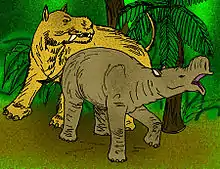Gobiatherium
Gobiatherium (meaning "Beast of the Gobi Desert") was one of the last uintatheres, from the Mid Eocene of Mongolia. Unlike its North American cousins, Uintatherium or Eobasileus, Gobiatherium lacked knob-like horns, or even fang-like tusks. Instead, it had enlarged cheekbones and an almost spherical snout.
| Gobiatherium Temporal range: | |
|---|---|
 | |
| Gobiatherium major and the pantodont Hypercoryphodon | |
| Scientific classification | |
| Domain: | Eukaryota |
| Kingdom: | Animalia |
| Phylum: | Chordata |
| Class: | Mammalia |
| Order: | †Dinocerata |
| Family: | †Uintatheriidae |
| Subfamily: | †Gobiatheriinae Flerov, 1952 |
| Genus: | †Gobiatherium Osborn & Granger, 1932 |
| Species | |
| |

Skull of Gobiatherium
Because of the noticeable lack of many diagnostic uintathere features (the horns and tusks), the genus is placed within its own subfamily, "Gobiatheriinae", though some experts prefer to rank it as the family "Gobiatheriidae".
References
- Cheng Jie & Ma Aneheng: New mammalian materials from the Eocene of the Liguanqiao basin. Vertebrata PalAsiatica 28, 1990, S. 228–244.
- McKenna, M.C. & Bell, S.K. Classification of Mammals Above the Species Level. 1997, Columbia University Press, New York. ISBN 978-0-231-11013-6
- Spencer George Lucas: Gobiatherium (Mammalia: Dinocerata) from the Middle Eocene of Asia: Taxonomy and biochronological Significance. Paläontologische Zeitschrift 74 (4), 2001, S. 591–600.
This article is issued from Wikipedia. The text is licensed under Creative Commons - Attribution - Sharealike. Additional terms may apply for the media files.